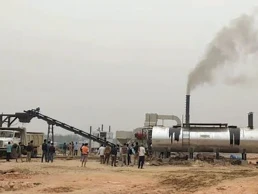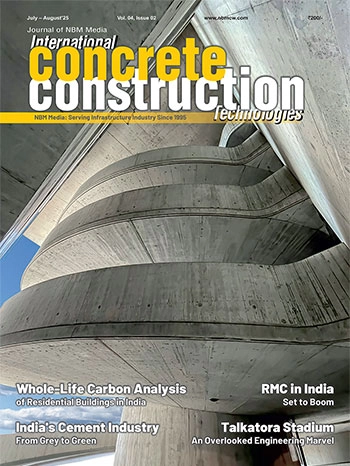Grinding Aids as Energy Saver in Cement Production
The benefits of using different grinding aids in cement production are improved output, decreased energy consumption, cost reduction, and minimizing the carbon footprint- all of which are steps forward in bringing greater sustainability in the cement industry.
Dr. Supradip Das, Consultant – Admixture, Waterproofing, Repair & Retrofitting, New Delhi

Cement production is a high energy consumed process. The electrical energy consumed in cement production is approximately 110 kWh/tonne, and around 40% of this energy is consumed for clinker grinding. It entails high cost and results in significant emission of Green House Gas (GHG). With the increase in the demand of higher grade cement for high performance concrete, cement manufacturers are exploring ways to optimize the use of grinding aids to obtain the required fineness at reasonably lower energy consumption. At the same time, it saves considerable amount of energy, and reduces agglomeration of particles on the balls & liners in the mill.
It has been reported (Heren, 1996) that grinding efficiency reduces as fineness increases, mainly due to the agglomeration between the particles. It also increases the reactivity, thus enhancing the reactivity of the cement and accelerating the hydration process, and shortening the setting.
Primarily, grinding aids are used during the grinding process to partially neutralise the charges present on the surface of clinker / cement particles. These particles are developed during grinding thus reducing the surface free energy of the material being ground. For this purpose, the additive molecules are adsorbed over the surface of the cement particles by weak electrostatic forces, favouring the repulsion and/or a steric hindrance between particles, avoiding their agglomeration, improving grinding efficiency. It increases the circulating loads with an improved particle size distribution.

Recently, the effect of grinding aids has been studied extensively. Many chemical species (amines, glycols, phenols, etc.) have been tested and evaluated using different parameters in the characterisation of the performance of these products. The evaluation of the grinding aid performance of the additives is normally carried out by monitoring the evolution of fineness with the operation time. The significance of this study lies in investigation of the possible advantages of using various types of grinding aids during clinker grinding process. From the earlier studies conducted, it can be concluded that the more representative parameters are:
In this regard, the effect of grinding aids have been studied extensively. Many chemicals (amines, esters of glycols, phenols, etc.) have been tested for the effects employing different parameters in the characterization of the performance of these products. Grinding aids are generally introduced by spray on the feed comprising of clinker, gypsum & mineral admixtures. Their main function is to neutralize partially the charge present on the surface of the clinker. According to one theory, grinding aids are constituted of polar organic compounds such as alkanolamines, which arrange their dipoles so that they saturate the charges on the newly formed particle surface, reducing re-agglomeration. Even at a very low dosage of 0.5% by weight of clinker, the efficiency of these additives are remarkable.
The evaluation of the grinding aid performance of the additives is primarily carried out by monitoring the evolution of fineness with the operation time. From the technical literature, it can be concluded that the more representative parameters are:
- Breakage rate (C) defined as the slope of the evolution of fineness with time.
- Grindability index (GI), defined as the ratio between the Blaine fineness and the number of mill revolutions required to achieve that fineness.

The present paper describes a series of lab study carried out in optimizing the dosage & type of grinding aid for a particular cement clinker.
Grinding procedure was set up by utilizing a lab mill, Bond type, in order to check the effectiveness of Grinding Aid components which are going to be studied on a specific clinker at variable dosage. Obviously the procedure adopted on a pilot plant scale has not much to do with the industrial process, since both particle size distribution and specific surface area result quite different in the two cases. Nevertheless, internal consistency using various aid could be checked & verified.
Ordinary Portland cement clinker as reference substrate, whose specific gravity is 3.11 g/cm3 and chemical composition, expressed in element oxides along with mineral phases are shown in Table 1 & 2. was used in all the tests.

Grinding Process
For grindability parameter, Blaine Specific Surface Area (BSS) developed during milling process was used
For grindability index tests in the laboratory, a laboratory Bond mill type has been used for clinker grindability test.

Revolution or rounds / minute : 70; grinding media loaded : 32.5 kg (balls Ø = 17-40 mm). 2 kg of clinker is loaded after comminution to a grain diameter < 3 mm. Samples were drawn as per IS : 3535

Blaine Specific Surface Area Measurements
After 150, 180 and 210 & 240 minutes, a sample of 5g of clinker is taken from the mill and its specific surface area is measured according to IS : 4031 (Part II) (Methods of physical tests for hydraulic cement: Part 2 Determination of fineness by specific surface by Blaine air permeability method (second revision).
 Table 4: Graph between Time & SSA developed
Table 4: Graph between Time & SSA developed
For measuring grindability parameters, Blaine Specific Surface Area (BSS) was used developed during milling process. Table 3 shows the BSS development utilizing some typical raw materials of GA at the dosage indicated.

SEM Study
S.R.M. Zan; K.E.H.K. Ishak6 studied the SEM behavior of the ground clinker (without GA) & GA with GA. Comparative study is given here. Figure 4 shows the SEM of the feed prior to the process, clearly shows the particles are in angular and irregular shapes, with a particle size below 2.36mm. This is typical of feed materials that have not been treated with grinding aids, as the grinding process can result in high energy consumption and low grinding efficiency, producing particles with less uniform size and shape, which can lead to poor flow properties and a reduced packing density, and affect the efficiency of downstream processing.
 Figure 5 : Time Vs Specific surface area
Figure 5 : Time Vs Specific surface area
Fig. 4a shows images of the particles after grinding with a particular GA. The grains of cement clinker after inter-grinding with GA were angular, rhomboid, flaky, and irregular grains. Smooth particles are desirable since they enhance the reactivity of the cement product, particularly during hydration.
Further studies with reduced GA using same materials mentioned above gave very encouraging results.

Energy Saving
Grinding clinker to cement consumes more energy than any other comminution process and can require 2.5–3.5 kWh/t of energy. When recycling material, it can require up to 10 kWh/t. In the conventional cement making process, about 70% of the 95–110 kWh of electrical energy per ton of cement is used for comminution, which includes grinding clinker.
Running load in Amp : 3Amp/phase.
Voltage – 415 V.
So - Converting Amps to KVA (voltage fixed)
KVA = Amps x Volts/ (1000 x PF)
= 3 X 415 / 1000 x 0.9
= 1.383333
Converting KVA to KW (Kilovolt-amps to Kilowatts)
KW = KVA x PF
= 1.383333 x 0.9
= 1.245 KW/Hr.
(Power factor (PF) is the ratio between real power and apparent power.)
Industrial Test
The data collected during this complete lab investigation were used during industrial trial in the grinding plant. The results confirmed what expected and it was possible to produce a CEM I with high early strengths (higher than 30 MPa at 24 h) at a reasonable cost and with interesting mill output.
Conclusion
The use of grinding aids is of extreme importance during production of high performance cements needed for top quality concrete. Besides the positive effects on reduction of agglomeration and improvement of mill efficiency, grinding aids have a strong chemical effect on cement hydration.
In order to optimize cement performances, several parameters should be taken into account. Chemical and mineralogical composition, grindability of clinker, amount of gypsum and cement fineness are probably the most important. The optimum gypsum can be very different if a grinding aid is used during cement production. This allows interesting results to be obtained, in terms of higher compressive strengths and better performances.
The benefits of using different grinding aids in cement production includes improved production, specific surface area of the end-products, decreased energy consumption, cost reduction & minimizing carbon footprint. The findings are really significant as it is a step forward in improving sustainability in the cement industry. The results of this study provide valuable insights into how the industry can improve its processes and become more sustainable, and demonstrate the importance of further exploring the use of grinding aids in cement production. These findings are path breaking in the form of sustainability in cement industry. By utilizing these findings, the industry can work towards reducing its energy consumption, costs, and environmental impact while continuing to meet the increasing demand for cement.
Acknowledgment
The author would like to thank H R Johnson for supporting this study.
Bibliography:
- Grinding Aids : A study on their mechanism of action. Bravo Anna, Cerulli Tiziano, Giarnetti Mariagrazia, Magistri Matteo Mapei S.p.A., via Cafiero 22, 20158 Milano, Italy. E-mail:
This email address is being protected from spambots. You need JavaScript enabled to view it. - Cement Grinding Optimisation : Dr Alex Jankovic , Metso Minerals Process Technology Asia-Pacific, Brisbane, Dr Walter Valery, Metso Minerals Process Technology Asia-Pacific, Brisbane, Australia Eugene Davis , Metso Minerals Asia-Pacific, Perth, Australia
- Low Cost Grinding Aids for Cement : Alejandro Pérez-Velázquez, José-Francisco Pérez-Calvo and Julián Martín Rubio, Production Manager, Proquicesa, Spain. World cement.com
- Energy Savings in Cement Industries : Sadeq Emeish, Dept of Chemical Engineering, Al Balqa Applied University, Jordon, 2013
- Effect of Grinding Aids in Cement Grinding : Syed Fuad S. Hashim and Hashim Hussin, Strategic Mineral Group, School of Material and Mineral Resources Engineering, 14300 Nibong Tebal, Penang, Malaysia
- A study of different grinding aids for low-energy cement clinker production : S.R.M. Zan; K.E.H.K. Ishak, School of Materials and Mineral Resources Engineering, Universiti Sains Malaysia, 14300 Nibong Tebal, Penang, Malaysia.

























































